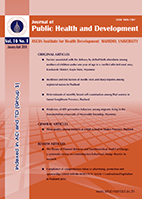Factors associated with the delivery by skilled birth attendants among mothers of children under one year of age in a conflict affected rural area, Kawkareik District, Kayin State, Myanmar
Main Article Content
Abstract
Reducing maternal and newborn mortalities is a global priority and the lives of mothers and newborns can be ensured by skillful care of skilled birth attendants (SBA) during and after childbirth. The impact of reducing child mortality and improving maternal health lead to improvement in global health development and reducing of poverty. Armed conflict areas have been affected by unequal distribution of maternal health services. Therefore, this study aimed to determine the prevalence and associated factors with delivery by a SBA in Kawkareik district, Kayin state, Myanmar.
A community based cross-sectional study was conducted in a rural area among women aged 15-49 years, who had a child under the age of one year. The data collection was conducted from April to May 2016. Multi-stage sampling was used to interview 245 women with a questionnaire, including constructs of the Health Belief Model. Logistic regression was used to examine predictors of delivery with a SBA.
Among 245 mothers, 54.7% had delivered with a SBA, 24.5% delivered with an auxiliary midwife and 20.8%
delivered with a traditional birth attendant. The factors associated with delivering with a SBA were, low mother’s education (Adj OR=0.10, 95% CI=0.03-0.32), low perceived seriousness (Adj OR=0.42, 95% CI=0.18-0.94), high perceived barrier (Adj OR=0.40, 95% CI= 0.20-0.84) and high perceived benefit (Adj OR=3.30, 95% CI= 1.20-9.07).
The SBA rate was low. Therefore, strategies are needed to focus on accessibility of services and developing
effective innovative intervention strategies, especially in a conflict affected area, through promoting the benefit in delivering with a SBA and child health and alleviate the problems that were found as perceived seriousness and perceived barriers on delivery with skilled birth attendants.


